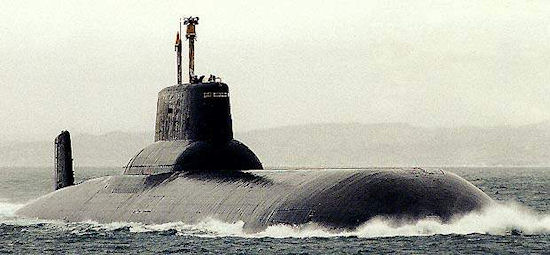The era of nuclear naval propulsion began in January 1955 with the commissioning of the USS Nautilus SSN-571.
The US Navy had begun to experiment with the construction, operational practices, and strategic value of submarines shortly after World War II. The Soviet Navy, having watched the effectiveness of the German submarines during the war, realized how the submarine could be a force-multiplier in naval operations.
The use of nuclear power, in combination with the change of the hull shape to improve hydrodynamic characteristics, would now allow submarines to remain submerged for unlimited periods of time without the need for diesel engines and battery charging, and to travel at much higher speeds.
Early estimates of USS Nautilus' operational capabilities stated that:
"She was hard to find because she never had to snorkel and so fast that active sonars couldn't keep their beams focused on her. Her speed and three dimensional maneuverability also allowed her to simply outrun existing homing torpedoes."
On the other hand, however, she was noisy, as the reactor water pumps emitted significant noise at low frequencies, as did the propeller shaft reduction gears.
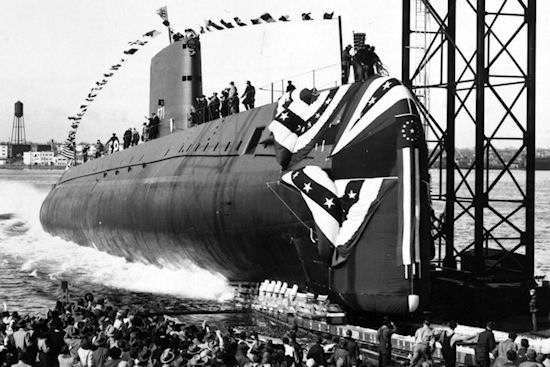 |
In this new era, the focus of anti-submarine operations was on passive sound-tracking methods, and the key parameter in the design of the new submarines was the reduction or containment of the noise. This vicious circle still remains the main axis of submarine design and operations.
The first Soviet nuclear submarine was the K-3 Ленинский Косомол (Leninski Komsomol), in 1958, launching the P627A class, designated November SSN by NATO (the official Soviet designations for most submarine classes were unknown at the time, and NATO used a name from the phonetic alphabet for each class).
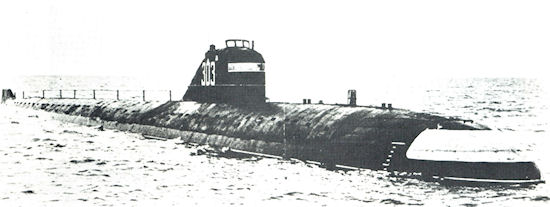 |
The technological developments that followed, were guided by the sizes and compositions of the US and the Soviet Navy, their operational requirements and played an important role in shaping their operational doctrines. Three types of nuclear powered submarines were developed, depending on the mission for which they were intended:
- Attack Submarines (SSNs) tasked with locating and destroying other submarines,
- Ballistic Missile Submarines (SSBNs) as ballistic missile launch platforms,
- Guided Missile Submarines (SSGNs).
The SSGNs were developed mainly by the Soviet Union as an antidote to the superiority of the US Navy in surface ships. The Soviet Navy acquired the first large surface ship in the early 1980s (Kirov cruiser) and the first and only real aircraft carrier in the late 1980s.
The early years
In September 1955 the Chief of Naval Operations, Admiral Arleigh Burke, officially announced that all new American submarines would be nuclear powered. A few months later the SSN 575 Seawolf was commissioned. She was used mainly as a test platform for a liquid metal reactor which at that time promised very good performance in small size. Seawolf's trials and many problems with the operation of the reactor led to the complete adoption of the pressurized water reactors and the abandonment of considerations for liquid metal reactors.
In 1957, the 1st of 4 submarines of the Skate SSN class was commissioned. The Skate class SSNs would pass rather unnoticed as they were just a transitional stage. In 1959 the first of the 6 Skipjacks entered service, the first to use the new "water-drop" hydrodynamic shape.
In 1959-60, 3 nuclear submarines were built serving largely as development platforms. These were Triton, Halibut and Tullibee. Tullibee is worth mentioning, since she was used to test the performance and capabilities of a very quiet turbo-electric transmission, without a steam turbine and the noisy reductions gears. This design resulted in a propulsion configuration of only 2,500 SHP compared to Skipjacks' 15,000 SHP, that translated to a maximum speed of just 20 knots. After Tullibee it was decided to abandon the effort to create different, mission-oriented types of SSNs, and to develop a single multi-mission platform. The result of this decision and the accumulated experience was the USS Thresser SSN 593, the first of the Thresser class SSNs, followed by 13 more submarines.
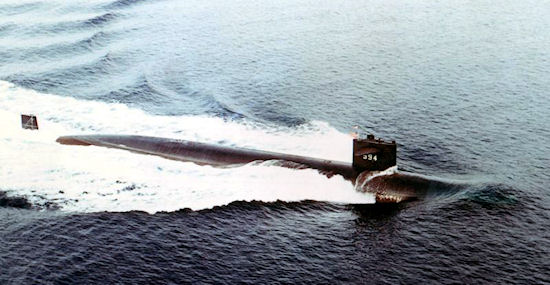 |
All subsequent US Navy SSN classes are based on the Thresser class, the first submarine type whose official primary mission was to hunt enemy submarines. The US Navy had already realized that the key to undersea warfare would be passive sound tracking. While previous classes, and most notably Tullibee, were trying to reduce noise by removing the factors that created it, Thresser designers made the additional effort to contain noise inside the submarine hull.
But apart from using a submarine as a hunter for other submarines, the value as a strategic weapon had already been recognized. In 1947 the US Navy had successfully experimented with the launch of a German V-1 from a diesel-powered Gato class submarine. In the early 1950s, a rocket launcher was evolved, and at about the same time the Soviet Union gained similar capabilities.
In 1957, it was decided to convert 2 of the planned Skipjacks into submarines with missile launching capabilities. Thus in 1959 the USS George Washington SSBN-598 (1959-1985) was commissioned, the first nuclear ballistic missile submarine. USS George Washington was the first of a series of 5 SSBNs carrying 16 Polaris A1 missiles with a range of about 1,000 nautical miles.
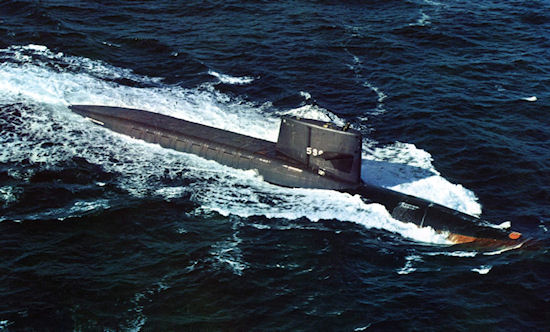 |
In the following decade, a total of 36 SSBNs of the Ethan Allen (5), Lafayette (19) and Benjamin Franklin (12) classes were commissioned and together with USS George Washington class became known as the "41 for freedom". These submarines would constitute the naval branch of the USA nuclear triad (intercontinental ballistic missiles-ICBMs, submarine-launched ballistic missiles-SLBMs, and strategic bombers) until the early 1980s when the Ohio class SSBNs appeared.
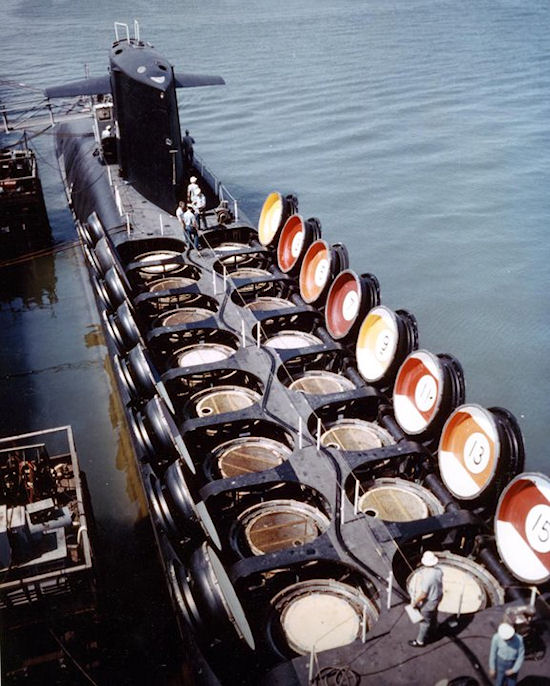 |
The first generation of Soviet nuclear submarines consisted of 4 classes: P627A (November SSN), P658 (Hotel SSBN), P659 (Echo I SSGN) and P675 (Echo II SSGN). There was already a first significant difference in the design parameters of the two superpowers. It was the development by the Soviets of the SSGN type of submarines, whose main mission was launching cruise missiles against US Navy aircraft carriers. The Echo class was essentially the nuclear-powered version of the conventional propulsion P651 class (Juliet SSG) and originally carried 6 SS-N-3 missiles with a 400-mile range (post 1962 replaced by 8 SS-N-12s).
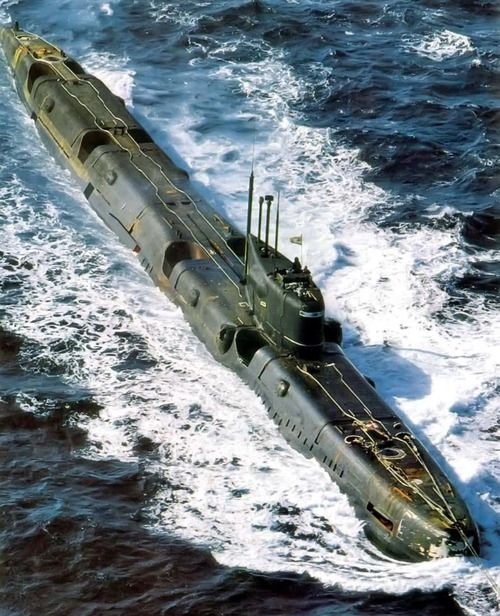 |
To launch their missiles, the Echos had to surface and either operate their medium range missile guidance radar or launch their missiles and hand their guidance to naval aircraft. When surfaced the submarines were extremely vulnerable to attack by aircraft and surface ships.
From 1958 to 1968 a total of 13 November, 8 Hotel and 34 Echo I and II were developed. Compared to the US Navy nuclear submarines of the same period, HENs (from the first letters of the three class names) were approximately equivalent to Nautilus and the Skates in terms of noise emission and particularly vulnerable to passive sonar detection. They were operating 2 nuclear reactors and were driven by 2 propellers, whereas the US submarines had 1 reactor and 1 propeller.
2nd generation nuclear submarines
The period from 1965 to the mid-1970s was marked by an obvious difference in design philosophy between the two superpowers. The US Navy was creating a new operational environment for submarines and the main design concepts were the effort to reduce noise emission and improve passive sonar detection methods and procedures. On the other hand, the Soviet Navy was trying to use the submarines to compensate for the huge disadvantage that existed in the surface fleets of the two countries and to deal with the tactical and strategic threats, created by the disparity. In this context, Soviet designs were sometimes much bolder and revolutionary, but the overall design effort was fragmented and did not divert adequate resources, early enough, to noise reduction/containment and passive detection.
The Soviet Navy developed some truly impressive submarines (ZhTS, Papa, Alfa) and was the first to achieve critical breakthroughs (submerged cruise missile launch capability). Any such development would initially cause grave concern in the US Navy, but most Soviet developments were technologically unstable and operationally problematic. In addition the US Navy never wavered from its basic two-fold (defensive-offensive) concept in submarine design: noise reduction and detection.
The first second-generation US nuclear submarine was the USS Sturgeon SSN 637 (1967-1994). Sturgeon was originally designed as a continuation of the Thresser class, but evolved into a new class. Noise frequency analysis and mechanical noise isolation systems were installed, utilizing LOFAR (Low Frequency Analysis and Ranging) signal processing techniques. At the same time the Thresser class submarines were fitted with towed sonar arrays. These two elements were also those that allowed for the first time the creation of libraries with the noise signatures of the Soviet submarines. Each class and even each ship had unique characteristics that could be analyzed and recorded through LOFAR. This lead to the capability to identify each individual Soviet submarine.
The sophisticated noise detection, processing and analysis systems in conjunction with the wider coverage bow sonar array and the towed sonar efficiency, provided the ability to follow a Soviet submarine from a short distance. Thus, the US Navy developed the tactic of covertly trailing hostile submarines at short distances. From 1967 to 1975, 37 ships of the Sturgeon class were commissioned, the last of which was decommissioned in 2004.
During the same period, two more SSNs were developed serving as platforms for testing new systems. These were the USS Narwall SSN-671 (1969-1999), and the USS Lipscomb SSN-685 (1974-1990). Narwall was used to test a convection cooling water flow system. Lipscomb was similar to Sturgeon except that she used a Turbo Electric Drive System. Although much quieter, the relatively low speed, heavy weight and bulk of electromechanical equipment precluded the use of TEDS, as was the case with Tullibee a few years back.
Second-generation Soviet submarines are divided into several different classes. Initially, the Soviet Navy tried to deal with its apparent lack of numbers and quality of SSBNs. Thus began the development of the Class P667A (Yankee) in 1964, which were essentially copies of the US George Washington class. A total of 34 Yankee I and II were developed, carrying (after 1972) 16 SS-N-6 missiles with a range of 1,700 nm. Many of the Yankees have undergone post-1977 modifications, mainly involving testing various types of ballistic missiles but also operating as special warfare platforms. Thus several sub-classes are often mentioned.
In 1972 the first version of the P667B (Delta) class appeared. The actual differences with the Yankees were small, after all, for the Soviet Navy it was just a variant of the latter. They initially carried 12 SS-N-8 missiles with a range of approximately 4,200 nm.
In the following years several versions of the Deltas appeared. A total of 18 P667B (Delta) I, 4 P667BD (Delta II), 14 P667BDR (Delta III) were constructed, and after 1985 7 P667BDRM (Delta IV) were commissioned, 6 of which remain in service to date. Obviously the Delta IVs, although by original design belong to the 2nd generation, incorporate many of the 3rd generation technological developments.
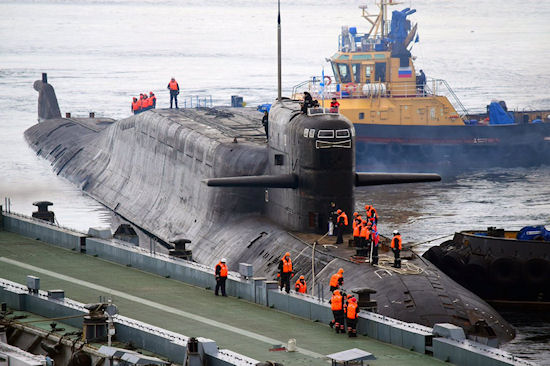 |
If for the 2nd generation SSBNs the Soviet designs were conventional, that was not the case for SSNs and SSGNs of the same period. Immediately after the commissioning of the 1st Soviet nuclear submarine, the design of an attack submarine, using 2 liquid metal cooled reactors, began. The result was P645 ZHT (1963). P645 ZHT had many problems with her reactors until a major accident in 1968 put her out of service.
In 1965, the P671 (Victor SSN) was introduced with the main mission of detecting and destroying hostile SSBNs. Compared to their modern counterparts, the Sturgeon class, Victors were much faster (+5 knots) but were much noisier and were the first Soviet submarines with 1 reactor. An important element of their equipment was the addition of a single torpedo with a nuclear warhead in an external tube. A total of 22 Victor I and II were commissioned, and in 1978 a variant was designated as Victor III. In this variant, for the first time, a serious attempt was made by the Soviet Navy to reduce and contain noise, while at the same time it was the first Soviet submarine equipped with a towed sonar array. Victor III was essentially the first indication of a shift in the design philosophy of the Soviet Navy towards sound insulation and passive detection, forming the link to the third generation of nuclear submarines that appeared in the 80's. 3 Victor III remain in service until today.
In 1969 the Soviet navy commissioned the fastest, active-duty, submarine ever built. The K-162 (P661, or Papa for NATO), was an SSGN that aspired to be the absolute antidote to the US Navy supremacy in surface ships. Little is known about her technical characteristics: the hull was constructed of titanium alloy, she was carrying 10 SS-N-9 missiles, and could reportedly reach and sustain the incredible speed of 44.7 knots while submerged. The price for this speed were the extremely high noise levels and a very high construction cost. Papa is not considered a class as no further submarines were constructed.
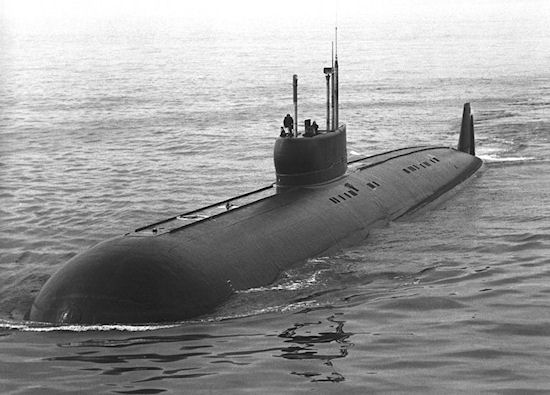 |
The 1960's ended with a significant evolution for Soviet submarines. In 1969 the P670A class (Charlie I) became the first in the world that could launch cruise missiles while submerged. Their appearance was almost simultaneous with the launch of the first Soviet satellites with missile guidance capabilities. These two parameters resolved many of the operational problems that the Echo class had encountered. The ability to launch a cruise missile while submerged and hand-over the missile guidance to the orbiting satellites vastly improved the survivability of the SSGNs and removed the operational restrictions that were inherent in the need of guidance by a maritime patrol aircraft.
But, significant problems in the operation and reliability of Soviet ocean surveillance satellites essentially removed one component of the problem for the US Navy, as Soviet SSGNs would continue to depend on maritime patrol aircraft for missile guidance. Eventually, only 17 Charlie I and II were built and never posed the threat that the US Navy was preparing for. The threat would become real 11 years later, with the commissioning of the Oscar SSGNs, combined with the development of new improved missile types and the efficient operation of ocean surveillance satellites.
The Alfa case
Alfa's were perhaps the most impressive, in terms of performance, submarines ever made. They were based on plans from the 1950s aimed in providing the Soviet Navy with a small attack submarine, capable of achieving high speeds. For this purpose a Liquid Metal Reactor cooled reactor was used, capable of delivering high energy while being small in size.
This resulted in an 80m-long submarine with a crew of 43, capable of developing speeds of up to 43 knots while submerged. This high speed forced the designers to anticipate much deeper operational and crush depths as a high-speed dive would very quickly bring her below the average operational depth of most submarines, without enough time for depth control. It was decided to use a titanium alloy for the hull of the ship and an entire factory was built solely for the necessary processing of the titanium for the Alfa hulls. Class P705 submarines (Alfa SSN) are said to have an operational depth of about 1,000m (nearly three times than most other submarines) and crush depth possibly below 1.200m. The first Alfa was commissioned in 1972 and caused real panic in the US Navy for a very simple reason. Although very noisy, thus easy to detect, the Alfa was almost impossible to destroy. The small size and maneuverability thanks to her high speed and deep diving ability, made it easy to evade the torpedoes of the era that had a maximum speed of 45 knots as they were designed to seek and destroy submarines that had a maximum speed of 30 knots (rule of 1.5) and a crush depth of 500m. This situation led the US Navy to speed-up the development of its new submarine-launched torpedo (the Mk48 ADCAP that remains until today the main submarine weapon) with improved performance to respond to the threat.
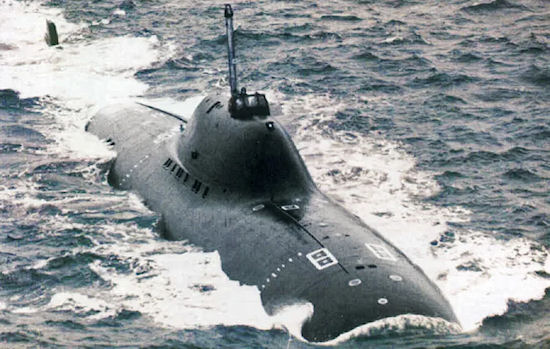 |
The Alfas never became the threat the US Navy prepared for. The high degree of automation of the submarine’s hardware, and in particular the reactor, resulted in frequent breakdowns and accidents, having the Alfas spent most of their time tied at the dock for repairs. Only 7 were built, serving in the Soviet (and then the Russian) Navy from 1972 to 1996, but never became operationally reliable units.
3rd generation nuclear submarines
In 1976 the USS Los Angeles SSN-688 was launched. Los Angeles-class submarines were designed with the primary mission of protecting US aircraft carriers from Soviet SSGNs and SSNs. It was the result of nearly 20 years of experience in the design, construction and operation of nuclear submarines and incorporated all the technological and manufacturing developments that made them extremely quiet and fast enough to accompany the aircraft carriers they were protecting. At the same time they carried the most sophisticated computer systems ever mounted on warships, with the primary aim of detecting and monitoring Soviet submarines.
A total of 62 shipe were built, 23 of which (after 1982) are often referred to as a separate class (San Juan or Los Angeles improved). To this day (2019) they are the backbone of the US Navy submarine fleet as 32 of them are still in service.
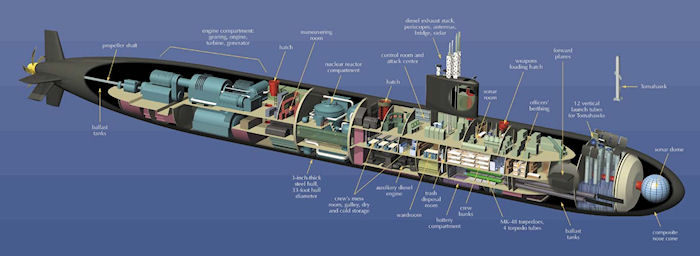 |
In 1981, the renewal of the SSBN fleet began with the commissioning of USS Ohio SSBN-726. With a displacement of 18,750 tn, these are the largest submarines constructed by the US and the quietest submarines ever made. Rumors have it that no submarine, not even an US Navy Los Angeles, has ever been able to detect and track an Ohio under normal operating conditions.
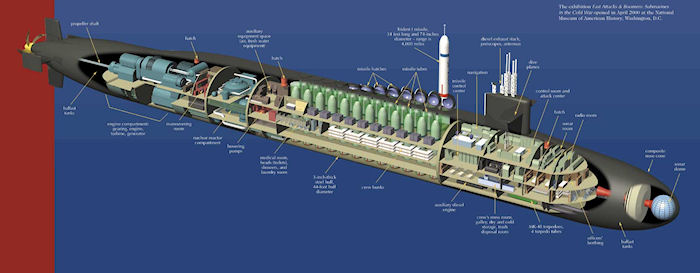 |
From the commissioning of the first vessel (USS Ohio SSBN-726) in 1981, until 1997 (USS Louisiana SSBN-743), when the class was completed, a total of 18 submarines were constructed. The operating cost of an Ohio is $ 50,000,000 per year. Today an Ohio carries 26 Trident II and I missiles with a range of 4,000nm. All 18 vessels remain in service, but the first four of the class (USS Ohio, USS Michigan, USS Florida, and USS Georgia) underwent extensive modifications from 2002 to 2008. These modifications resulted in their conversion to SSGNs, no longer carrying ballistic missiles but 154 Tomahawk cruise missiles and facilities to accommodate and support the operation of Special Forces detachments.
When the first P949 (Oscar I SSGN) appeared in 1980, NATO believed it was a new type of SSBN. With a displacement of 16,000 tn (at Oscar II it reached 20,000 tn) and a length of 154m, she was slightly smaller than the Delta III SSBN and the Ohio SSBN. Her size, combined with the double hull (an inner pressure hull and an outer hydrodynamic hull, and between them 15cm filled with soundproof material) ensures the Oscars a great chance of surviving even a direct hit from a conventional torpedo. They carry 24 cruise missiles SS-N-19 with a range of 300nm. The Oscars, even after the collapse of the Soviet Union, are still surrounded by secrecy as to their exact number, and many of their technical characteristics. There were 2 Oscar I's that were decommissioned in the mid 1990's and 12 Oscar II's, 4 of which were decommissioned and the Kursk lost in the notorious accident. Without a doubt, the Oscar II are among the most sophisticated submarines ever built and their conventional firepower could destroy the entire navy of most countries in the world in a single engagement. There have been a few cases, even after the fall of the Soviet Union, where Oscar SSGNs have been located near the US coast trailing US Navy aircraft carriers groups.
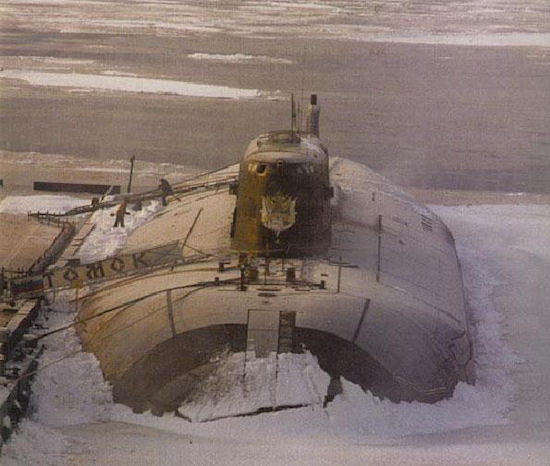 |
The new Soviet submarine that appeared in 1981 could not be anything else than a SSBN. The Typhoon P941 SSBN, with a length of 172m and a displacement of 33,800tn, is bigger that most World War II aircraft carriers and the largest submarine ever built. The Typhoons carry 20 SS-N-20 missiles with a range of 5.500nm. They are also the only SSBNs with the missile compartment in front of the conning tower. A total of 6 vessels were built, of which 1 remains in service.
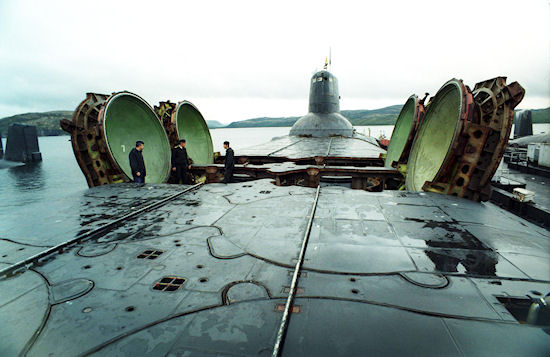 |
The Soviet Navy made another important step forward with the P971 / 971U (Akula I, II SSN). Three subclasses are mentioned: the original design, the improved Akula and the Akula II. The exact distribution of the 15 boats built in the three suclasses is uncertain. Most likely, the improved Akula came into service in the late 1980s, while the Akula II in the early 90s. The improved Akula is considered to be equal to the original Los Angeles SSNs in noise levels, and many other operational capabilities, while the Akula II is believed to be at least at the level of improved Los Angeles SSNs. In any case, the Akula II (along with the Sierra II) are certainly the most "quiet" ever made by the Soviet Union. 11 of them remain in service.
The unique submarine of the 685 project with the Soviet name Комсомолец (Komsomolets) and NATO's designation Mike, remains largely mysterious. Even after the collapse of the Soviet Union little became known about this vessel. The submarine entered service in 1984 and was designated as an SSN. Most likely it was a test platform for sophisticated weapon and electronic systems, with the capability of launching torpedoes and cruise missiles with conventional and nuclear warheads. On April 7, 1989, while cruising at a depth of 200m, and about 100nm southeast of Bear Island, near the Norwegian coast, a fire erupted. Although the crew was able to surface and fight the fire for about 6 hours, the boat eventually flooded and sank. 41 people were killed and 25 were rescued. Комсомолец wreck remains at a depth of about 1,600m.
In 1984, another Soviet SSN class, P945A / B (Sierra I, II SSN), appeared. It is generally accepted that the Sierra could have evolved into the most dangerous opponent of US submarines, but the very high construction cost along with the economic reforms of the Gorbachev era, led to the development of the cheaper Akula class. Only 4 Sierra's were built, still in service.
21st century and a new world
When the design of the new class of American SSNs that would replace the Los Angeles class, began in 1984, the Soviet Union was still a mighty opponent, and in the minds of the designers were the requirements of the Cold War and the operations against Soviet submarines. When the first submarine of the new class, the USS Seawolf SSN-21, was delivered to the US Navy (1997), the Soviet Union no longer existed and the Russian Navy was plagued by financial problems that dramatically affected the operational readiness of all the units, including the submarine fleet. Only a handful of units were actually sailing, while the largest part of the impressive, in numbers, submarine force was actually rotting at the docks.
Submarines of the Seawolf class are faster, larger and much quieter than any other SSN class ever manufactured. It is said that a Seawolf cruising at 25knots is "quieter" than a Los Angeles tied at the pier. They can carry a greater number of torpedoes and cruise missiles, and deliver them with a higher rate of fire that any other SSN. Also the use of HY-100 steel (compared to the HY-80 used in the past) is said to have lowered the operational depth at around 550m (according to other sources at 650m). However, the Soviet / Russian submarines that the Seawolf class was designed to hunt down and destroy, were either being decommissioned or at their bases in a state of reduced readiness, rarely venturing in the open sea. At the same time, threats against the US were taking other forms for which the Seawolf class capabilities were of little or no importance. All this combined with the very high construction ($ 2.8 billion per hull) and operation costs, led the US Navy to scrape the rest of the class’ hulls. Of the 29 boats to be built, only 3 were finally delivered before the program was canceled.
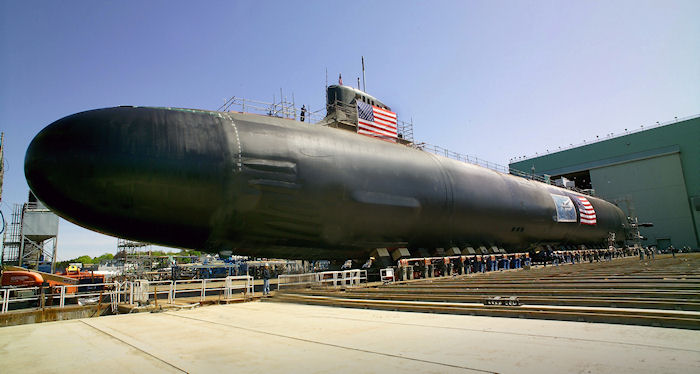 |
Most of Seawolf's systems have been transferred to a new class of smaller and cheaper SSNs, which began with the commissioning of the USS Virginia SSN-774 in 2004. A further 17 submarines followed, with 10 still under construction.
A new SSBN class for the US Navy is also in the designing and planning phase. The Columbia SSBN is due to begin construction in 2021 and will replace the Ohio SSBNs. Initial planning provides for the construction of 12 Columbia SSBNs.
After the collapse of the Soviet Union, Russia was rather embarrassed about managing its huge fleet of nuclear submarines. Several new vessels were in different stages of construction. Most of them were canceled and only those that were at a very advanced stage were delivered with very long delays. Russia had to manage the planning of the former Soviet Navy, but with an infinitely smaller budget. It took 18 years from the fall of the Soviet Union to deliver the first submarine of a new class in 2009. It was the K-535 Yuri Dolgoruki the first of the Borei SSBN class, the first class of Russian submarines to become known by its real Russian name. The Boreis are much smaller than the Typhoon beasts that they replace, but they have significant advantages in terms of noise emitted and construction and operating costs. 4 boats of the class have been delivered and another 4 are under construction.
The first new Russian SSN appeared in 2013. It is the K-560 Severodvinsk that initiated the P885 Yassen SSN class. She is based on the Akula and Alfa classes and is expected to replace all Soviet-era SSNs and SSGNs. Early estimates call them the quietest Russian submarines, superior to Los Angeles but not as "quiet" as a Seawolf or a Virginia. However, it seems that the difference between modern US and Russian SSN classes capabilities is smaller than any other period of the nuclear age. Two vessels of the class Yassen SSN have been delivered and 5 are under construction.
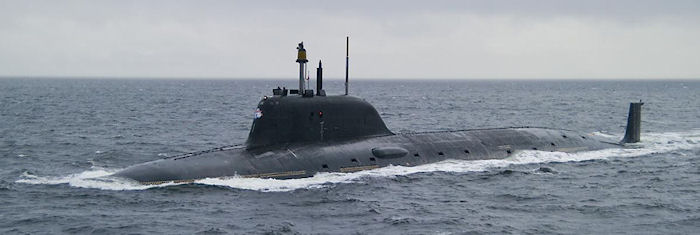 |
The nuclear submarines of other countries
In 1963, the first third-country nuclear submarine appeared. Using the US Skipjack hull and reactor, Great Britain commissioned the HMS Dreadnought S101.
- In 1966, the SSN Valiant was commissioned, followed by five vessels remaining in service until 1994. She was essentially the operational version of the Dreadnought using a British reactor and being slightly longer. It appears that they were initially designed for operations against surface ships. The modifications that they had over the years have also made them effective against other submarines.
- In 1968, the 1st Royal Navy SSBN appeared, largely similar to the American Lafayette, carrying 16 Polaris A3 missiles. The HMS Resolution S22 SSBN was the 1st of the class, followed by 3 others. Remained in service until 1996
- In 1973 the development of the 6 Swiftsure SSNs from Great Britain began, They were an evolution of the Valiant class, with significant improvements in noise reduction. Swiftsure SSNs were gradually decommissioned with the latter being stricken in 2010.
- In 1983 the HMSTrafalgar S107 SSN was delivered, the first of a series of 7 submarines of which 3 remain in service
- In 1993 the HMS Vanguard S28 SSBN was delivered, followed by 3 more. All 4 submarines remain in service
The latest class of British nuclear submarines was launched with the HMS Astute S119 SSN in 2010. 4 submarines are in service while another 3 under construction.
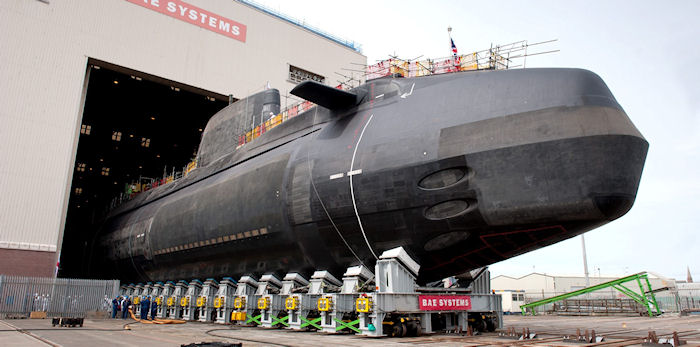 |
China also begun its efforts to develop nuclear powered submarines in the 1950s. However, it wasn’t until 1974 that the Han SSN was launched. The 5 submarines of the class originally carried only torpedo tubes and although they were retrofitted to carry surface-to-surface missiles, they still had significant launch problems. Their most important problem is the high radiation count inside the hull. 3 of the 5 vessels remain in service. In 1988 the Xia SSBN was delivered and for 19 years was the only SSBN in PRC Navy. In 2007 the first of the 6 Type 094 SSBNs was delivered.
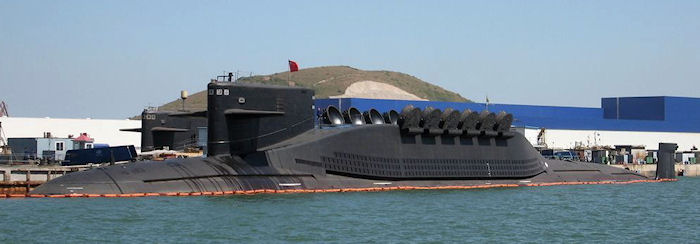 |
France was the first country to commission an SSBN before an SSN. In 1976 the Redouptable S611 SSBN appeared, followed by 5 more hulls. The last submarine of the class was decommissioned in 2008. The first French SSN was commissioned in 1983 (Rubis S601 SSN), starting a class of 4 submarines. In the 1990s, another 2 of the Amethyste class SSNs, were commissioned all of which are still in service. In 1997 the 1st of the 4 Triomphant SSBNs was commissioned, all of them remaining in service to date. The 1st of the 3 new Barracuda SSNs that will replace the Rubis SSNs, is expected to be commissioned in 2020.
India is the youngest member of the club of countries operating nuclear submarines. As it was revealed several years later, the Soviet Union had leased to India a Charlie I SSGN submarine from 1988 to 1991, as a political move to strengthen the ties between the two countries. With the collapse of the Soviet Union, the submarine was returned to Russia. In 2012, Russia leased an Akula-class SSN under construction since 1994. India funded the completion of the submarine with a lease agreement extending to 2025. In 2016, India introduced the first SSBN, INS Arihant, with another 3 under construction.
Finally, Brazil has announced the existence of a SSN design program, with the launching of the 1st hull scheduled for 2024.
The future of nuclear submarines
The future of nuclear submarines depends to a large extent on the threats to which they are required to respond. This in turn depends on the geopolitical environment.
The US Navy faced a "identity crisis" in the 1990s regarding the role and value of nuclear submarines in a world without the Soviet Union. The Russian Navy faced a much tougher situation with funding and organizational problems that essentially did not allow it to operate and maintain its weapons systems, including nuclear submarines.
Gradually, during the 2000s, and after reviewing the technical and operational requirements, along with the actual size of the submarine fleets, a new, slightly differentiated situation emerged with key features:
- US and Russian ballistic missile submarines (SSBNs) continue to carry out deterrence patrols
- US and Russian nuclear attack submarines (SSNs) continue to have their counterparts and SSBNs as their main adversary, even if the related operations no longer have the intensity of the Cold War era.
- The involvement of submarines in operations against ground targets (cruise missile strikes) and special forces operations in various regional conflicts has increased
- Operations against third countries’ conventional propulsion submarines are now an important part of tactics
- China is viewed by both traditional "players" as an increasingly serious threat
In the period after World War II, the development of conventional propulsion submarines had greatly downgraded. The post-war US and Soviet efforts to develop AIP (Air Independent Propulsion) submarines were virtually abandoned because of nuclear propulsion.
After 1990, efforts to improve conventional submarines became more systematic and modern AIP systems evolved. The first submarines to come up with modern AIP systems were the Swedish Gotlands on1996. There are currently over 10 versions of conventional submarines with AIP systems. Among these are the German type 209-1400mod (Ocean S118 of the Hellenic Navy) and type 214 (Papanikolis S120, Pipinos S121, Matrosos S122, Katsonis S123 of the Hellenic Navy).
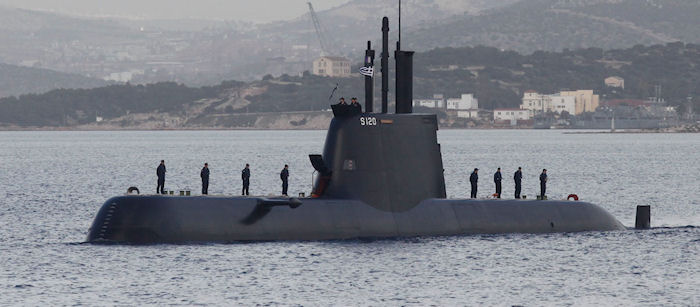 |
This type of submarines comes to challenge the superiority of nuclear-powered submarines, at least in operations in shallow waters, close to the shore or in restricted sea areas, with their main feature being the extremely silent propulsion system for adequate time periods and with an acceptable submerged speed. Current US Navy operational tactics consider the encounter of a nuclear submarine with an AIP submarine, in a relatively confined area, as one of the most challenging underwater warfare scenarios.
Submarines’ Reactors
The reactors used in nuclear submarines were and are mainly pressurized water reactors (PWRs). The primary coolant used to extract heat from the reactor core and generate steam in the secondary circuit is water under pressure.
The fuel used in naval nuclear reactors is highly enriched uranium. The enrichment ranges from 20-25% for US Navy reactors and about twice as high as for the Russian Navy. It should be noted that the corresponding enrichment rate for a commercial nuclear power reactor is 3-4%.
The Soviet Union was the only country to use liquid metal cooled reactors (LMRs) in operational submarines (the only US Navy submarine using an LMR was the USS Seawolf SSN-575, but the reactor was soon replaced by a PWR). Their main advantage is that they produce more power with a smaller size than PWRs. They were essentially used only on the K-27, the only one of the 627 ZhTS Project, and on the 7 Alfa Class SSNs. The metal used as a coolant was a lead-bismuth mixture with a freezing point at 125 ° C and a boiling point at 1,680 ° C.
The thermal output of the submarines’ reactors ranges from 50-190 MW depending on the size of the submarine. Russian, American and British submarines use steam turbines to drive the propeller shaft, while Chinese and French submarines use steam to generate electricity, which drives the boat. Most Russian submarines are powered by 2 reactors, while American, British, French and Chinese by 1, with few exceptions.
The overall picture in numbers
To date (2019), 531 nuclear submarines have been manufactured by the Soviet Union / Russia, the United States, the United Kingdom, France, China and India. 153 are still in service (2019). Of these, 95 are attack submarines (SSNs), 9 are guided missile submarines (SSGNs), 46 are ballistic missile submarines (SSBNs), and there are 3 submarines used as testing platforms or for special purposes.
The total numbers of nuclear submarines per country.
Out of parenthesis is the number of nuclear submarines currently active. In brackets the total number of nuclear submarines manufactured by each country. Descending order by number of total manufactured.
Soviet Union / Russia: 44 (255)
US: 71 (210)
Great Britain: 11 (31)
China: 16 (18)
France: 10 (16)
India: 1 (1)
The numbers of attack submarines (SSNs) by country:
US: 53 (150)
Soviet Union / Russia: 20 (91)
Great Britain: 7 (23)
China: 9 (11)
France: 6 (6)
Guided Missile Submarines (SSGN) numbers by country:
Soviet Union / Russia: 9 (66)
USA: 0 (1)
Ballistic Missile Submarines (SSBN) numbers by country:
Soviet Union / Russia: 12 (95)
US: 18 (59)
France: 4 (10)
Great Britain: 4 (8)
China: 7 (7)
India: 1 (1)
See the next chapter of the series: Nuclear submarines in the Cold War
See the entire series of articles on nuclear submarines
The silent war
Basic concepts in submarines' evolution
The true submarine
Nuclear submarines in the Cold War
Nuclear submarines accidents (coming soon)
Nuclear propulsion and the environment (coming soon)




